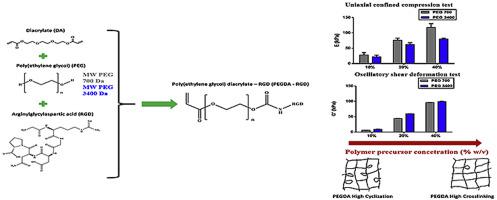物理缠结的聚合物水凝胶的生物医学应用通常由于其弱的机械性能,在生理相关环境中的快速溶胀和溶解而受到限制。化学交联有助于稳定水凝胶结构并增强机械性能,从而在生理环境中具有更高的稳定性。在这种情况下,已知水凝胶的机械性能受起始聚合物的分子量(MW)和交联剂浓度的影响。在这里,我们的目的是评估聚合物MW和前体溶液浓度对最终水凝胶力学特性的影响及其对细胞与材料相互作用的影响。详细,基于两种分子量(PEG 700和PEG 3400)和三种不同浓度(10、20、40 w / v%)的聚(乙二醇)二丙烯酸酯(PEGDA)的3D合成基质,它们使用darocour作为引发剂进行光聚合,进行了研究。然后,进行了红外和溶胀分析,并对获得的水凝胶进行了全面的机械表征(即,振荡剪切和密闭压缩测试)。最后,为了评估机械特性对生物学行为的影响,在用三种不同浓度的RGD肽功能化底物后,根据细胞粘附百分比和细胞生存力对水凝胶进行了表征。结果表明,水凝胶的压缩杨氏模量(E)和剪切弹性模量(G')都随聚合物前体浓度的增加而增加。E随着MW增加而降低,并且差异与更浓缩的水凝胶更相关。相反,G'似乎随着PEGDA MW的增加而增加,特别是对于最低的聚合物前体浓度。生物学结果表明,培养时间较长的细胞似乎更喜欢具有较大筛孔结构的PEG 3400水凝胶,该结构具有较高的剪切粘弹性。G′似乎随着PEGDA MW的增加而增加,特别是对于最低的聚合物前体浓度。生物学结果表明,培养时间较长的细胞似乎更喜欢具有较大筛孔结构的PEG 3400水凝胶,该结构具有较高的剪切粘弹性。G′似乎随着PEGDA MW的增加而增加,特别是对于最低的聚合物前体浓度。生物学结果表明,培养时间更长的细胞似乎更喜欢具有较大筛孔结构的PEG 3400水凝胶,该结构具有较高的剪切粘弹性。
 "点击查看英文标题和摘要"
"点击查看英文标题和摘要"
Mechanical behavior of bioactive poly(ethylene glycol) diacrylate matrices for biomedical application.
The biomedical applications of physically entangled polymeric hydrogels are generally limited due to their weak mechanical properties, rapid swelling and dissolution in physiologically relevant environment. Chemical crosslinking helps stabilizing hydrogel structure and enhancing mechanical properties, thereby allowing a higher stability in phisiological environment. In this context, it is known that the mechanical properties of the hydrogel are affected by both the molecular weight (MW) of the starting polymer and the concentration of the crosslinker. Here, our aim was to assess the influence of polymer MW and concentration in the precursor solution on the mechanical features of the final hydrogel and their influence on cells-material interaction. In detail, 3D synthetic matrices based on poly(ethylene glycol) diacrylate (PEGDA) at two molecular weights (PEG 700 and PEG 3400) and at three different concentrations (10, 20, 40 w/v %), which were photopolymerized using darocour as an initiator, were studied. Then, infrared and swelling analyses, along with a comprehensive mechanical characterization of the obtained hydrogels (i.e. oscillatory shear and confined compression tests), were performed. Finally, to evaluate the influence of the mechanical features on the biological behaviour, the hydrogels were characterized in terms of cell adhesion percentage and cell viability after functionalizing the substrates with RGD peptide at three different concentrations. Results have demonstrated that both the Young’s modulus (E) in compression and the elastic modulus (G’) in shear of the hydrogels increase with increasing polymer precursor concentration. E decreased as MW increased, and the differences are more relevant for more concentrated hydrogels. On the contrary, G’ appears to increase with increasing PEGDA MW and in particular for the lowest polymer precursor concentration. The biological results have demonstrated that cells cultured for longer times seem to prefer PEG 3400 hydrogels with a larger mesh size structure that posses higher viscoelastic properties in shear.




















































 京公网安备 11010802027423号
京公网安备 11010802027423号